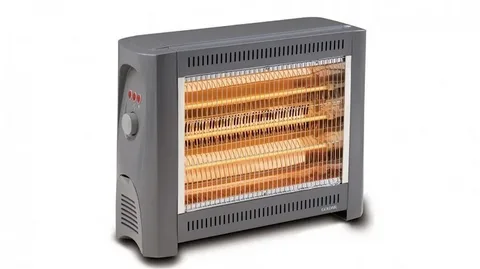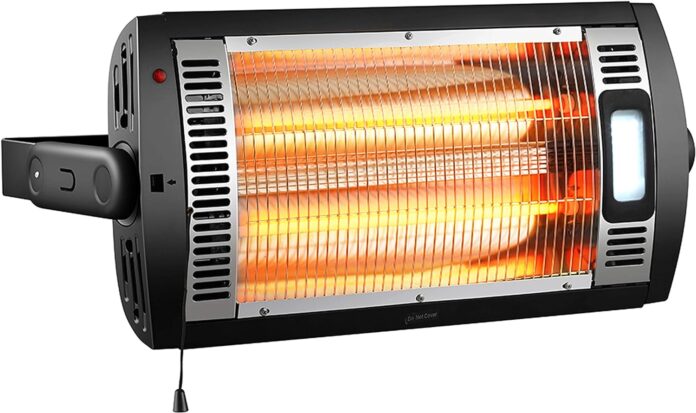When the temperature drops, staying warm and Cosy becomes a top priority. An electric radiant heater is one of the best ways to achieve this. Whether you want to heat your home, office, or outdoor space, an electric radiant-heater can provide efficient and practical warmth. In this comprehensive guide, we will explore everything you need to know about electric radiant-heaters, from understanding how they work to the benefits they offer and tips for installation and maintenance.
Understanding Electric Radiant-Heating Systems
Electric radiant-heating systems operate on a principle distinctly different from conventional heating methodologies. At the core of these systems lie electric coils or cables that, upon being energized, produce heat. This warmth is not indiscriminately dispersed into the air but is instead directed towards objects and surfaces within a room. The brilliance of this mechanism lies in its direct approach, ensuring that heat is not squandered but utilised where most needed.
These systems are a departure from the forced-air heating techniques that many are accustomed to, where warmth is often lost in transit before it even reaches the occupants of a space. By heating the objects in a room, electric radiant systems create an environment where warmth is retained more effectively, fostering a uniform temperature distribution across the area. This method not only enhances comfort but also contributes to the efficiency of the heating process.
The technology underpinning electric radiant-heating systems is versatile, allowing their integration into various parts of a structure, including walls, ceilings, and floors. The latter application, often called underfloor heating, is especially popular for its even, gentle warmth, creating an inviting atmosphere in any home. Electric radiant-heating systems exemplify the evolution of space heating, offering a method that is both efficient in its energy use and effective in providing comfort. Their design and operational methodology are significant in approaching the challenge of heating our living and working environments.
Installation and Maintenance of Electric Radiant Heating System
Embarking on installing an electric radiant heating system is often seen as a project within the grasp of those adept at DIY, provided that one adheres stringently to the guidelines laid out by the manufacturer. This careful adherence ensures a successful installation and optimises the system’s efficacy. A crucial consideration is preparing the space where the system is to be installed, which may include the subfloor in the case of underfloor heating, ensuring it is clean, level, and free of debris that could impair the system’s function.
Once installed, the key to maintaining the efficiency and longevity of your electric radiant-heating system lies in a routine of simple yet effective care practices. Regular inspections should be conducted to identify potential issues, such as damage to the heating elements or wiring, which could affect performance or pose safety risks. Keeping the areas around the heaters free from obstructions is also advisable to ensure optimal heat distribution.
For systems installed within floors, it is paramount to be mindful of the materials placed over them. Heavy furniture or sharp objects can damage the heating elements embedded beneath the surface. Therefore, applying protective measures or using furniture compatible with radiant heating is recommended. Engaging in these practices secures the operational integrity of your electric radiant-heating system. It accentuates the comfort and warmth it brings to your space without the recurring need for professional intervention.
The Benefits of Electric Radiant-Heaters
Electric radiant-heaters can directly warm objects and surfaces without the intermediary step of heating the air. This direct heating method results in a more efficient use of energy.
Enhanced comfort levels
The warmth emitted by electric radiant-heaters mimics the sun’s natural warmth, providing a more comfortable and evenly distributed heat than conventional heating methods.
Space conservation
Given their installation flexibility, electric radiant-heaters can be incorporated into walls, ceilings, or floors. This aspect is particularly advantageous for smaller spaces where conserving floor area is essential.
Health benefits
These heating systems do not circulate air, making them an excellent choice for individuals with allergies or respiratory concerns. The lack of air circulation means fewer allergens and dust particles are spread throughout the space.
Quiet operation
Electric radiant-heaters operate silently, lacking the noisy fans associated with forced-air systems. This quiet operation ensures a peaceful indoor environment.
 Reduced heat loss
Reduced heat loss
Because radiant heat is directly emitted, there is minimal heat loss, making them more efficient than other heating options where heat can escape before reaching the intended area.
Low maintenance requirements
Electric radiant-heating systems generally require less maintenance than traditional heating systems, owing to their fewer moving parts and the absence of ducts that need regular cleaning.
Exploring Outdoor Radiant Heaters
Outdoor radiant heaters are ingeniously designed to make the chill of the colder months bearable, allowing the enjoyment of outdoor living spaces such as patios and gardens throughout the year. These heaters radiate infrared heat directly to objects and people rather than warming the air, which is especially effective in open outdoor environments where heated air can easily be lost. The range of outdoor radiant-heaters is vast, encompassing various sizes, styles, and installation options to suit diverse outdoor settings. From sleek, wall-mounted units that blend seamlessly with your outdoor décor to portable, freestanding models that can be moved as needed, there is a solution for every outdoor heating requirement.
Selecting the perfect outdoor radiant heater involves consideration of the specific characteristics of your outdoor space. Wall-mounted models are ideal for compact areas where floor space is at a premium. In contrast, freestanding heaters offer flexibility in positioning and can be a focal point in more extensive gardens and patios. Modern outdoor radiant-heaters are built to withstand the elements, incorporating weather-resistant materials and design features to ensure durability and sustained performance. This resilience makes them a reliable source of warmth, even in adverse weather conditions, extending the usability of outdoor areas and enhancing the outdoor living experience during cooler months.
Choosing the Right Outdoor Infrared Heater
Calculate the dimensions of your outdoor area to ensure the chosen infrared heater’s output matches your space requirements. This ensures effective and efficient warming.
Style considerations
Select a heater that complements your outdoor aesthetics. Whether you prefer a discreet wall-mounted unit or a decorative freestanding model, the design should enhance your outdoor ambience.
Weatherproof features
Ensure the outdoor infrared heater is equipped with weather-resistant properties to withstand the UK’s unpredictable climate. Look for models with IP ratings that strongly resist rain and dust.
Energy efficiency
Opt for a heater with adjustable settings and energy-saving features like timers or thermostats. These can significantly reduce energy consumption while maintaining comfort.
Installation flexibility
Consider the installation requirements of your outdoor heater. Some models may necessitate professional installation, especially hardwired ones, whereas others are plug-and-play, offering immediate warmth with minimal setup.
Safety attributes
Safety is paramount. Look for outdoor infrared-heaters with built-in safety features such as auto shut-off mechanisms, tilt protection, and cool-to-touch surfaces, especially if you have children or pets.
Warranty and support
A robust warranty and accessible customer support reflect the manufacturer’s confidence in their product and provide peace of mind. Priorities heaters that come with comprehensive coverage and responsive after-sales service.
Maximising Efficiency with Warm Floors Radiant Heating
Installing warm floors radiant heating beneath your flooring materials elevates your home’s comfort levels and contributes significantly to energy efficiency. By directly warming the floor, which radiates heat upward into the living space, these systems ensure that warmth is precisely where you need it most, reducing the need for higher thermostat settings and thus cutting down on energy usage. One of the critical advantages of underfloor heating is its ability to provide consistent temperature across a room.
Unlike conventional heating methods that can create unevenly heated spaces, with warm spots near heaters and more excellent areas further away, radiant floor heating eliminates these disparities, ensuring a uniformly comfortable environment. This uniformity plays a pivotal role in maximising the system’s efficiency, as it negates the necessity for overcompensating in colder areas, which typically leads to increased energy consumption. For those contemplating the integration of warm floors radiant-heating into their homes, it’s essential to consider the type of flooring under which the system will be installed.
Materials such as tile and stone are highly conductive, making them ideal companions for underfloor heating, as they enhance the system’s efficiency by effectively distributing the heat produced. Engaging in intelligent heating practices, such as utilising programmable thermostats, can further optimise energy usage, allowing for the precise control of heating based on your schedule, thereby ensuring that energy is not wasted heating a space.
Environmental Impact of Radiant Heating System
The ecological advantages of radiant heating system is particularly noteworthy, aligning well with the growing concern for sustainable living practices. These systems utilise electricity, a resource that can be derived from renewable sources, to generate heat. This distinction means that, unlike traditional heating methods that may depend on the combustion of fossil fuels, radiant heating has the potential to operate with a significantly reduced carbon footprint. Moreover, the inherent efficiency of radiant-heating systems translates into lower energy demand.
This efficiency is partly due to the precise nature of radiant heating, which targets warmth exactly where needed, thereby avoiding the energy wastage commonly associated with other forms of heating. As energy consumption diminishes, so does the environmental impact, marking radiant heating as a forward-thinking choice for those committed to reducing their ecological footprint. Additionally, the absence of forced-air movement in radiant-heating systems minimizes the dispersal of dust and allergens, contributing to a healthier indoor environment and further underlining the system’s environmentally friendly credentials.
Conclusion
Electric radiant heater presents a compelling heating option for various settings, encompassing residential, commercial, and outdoor environments. These systems underscore a commitment to enhancing comfort, promoting energy efficiency, and reducing environmental impact. Integrating electric radiant heating technology into everyday living spaces signifies a move towards more sustainable and health-conscious heating solutions. Embracing these systems means choosing a method that aligns with contemporary needs for efficiency, convenience, and ecological responsibility.
FAQs
Q: Is electric radiant heater safe for indoor and outdoor use?
A: When installed according to the manufacturer’s guidelines and used correctly, electric radiant heater offers high safety. It’s crucial, however, to select the right type for your specific environment—indoor models for your interiors and weather-resistant versions for outdoor spaces. Adhering to safety instructions minimizes risks, making these heaters a secure choice for warmth.
Q: Can I install an electric radiant-heating system in my existing home?
A: Electric radiant-heating systems can be retrofitted into existing homes. The process might involve some structural modifications, especially for underfloor heating installations. It’s advisable to consult a professional to assess your home’s compatibility and ensure the installation is conducted efficiently and safely.
Q: How do electric radiant-heaters compare energy efficiency to traditional heaters?
A: Electric radiant-heaters are highly efficient in their operation. They work by directly heating objects and surfaces rather than the air, minimising heat loss and ensuring that warmth is felt quickly and maintained for extended periods. This direct heating method can lead to lower energy consumption and, consequently, reduced energy bills compared to traditional heating methods that heat the air.
Q: What maintenance do electric radiant-heating systems require?
A: One of the advantages of electric radiant-heating systems is their minimal maintenance requirements. For systems installed within floors or walls, little maintenance is needed. However, it’s good practice to periodically check the system for any signs of wear or damage and to keep the areas around radiators or underfloor heating clear of obstructions to ensure optimal performance.
| Other Good Articles to Read |
| Blogs Rain |
| Cme Blog Spot |
| Garcias Blogs |
| Yyc Blogs |
| Blogs-Hunt |
| Impact-Blog |
| Smarty Blogs |
| Ed Blog |
| Mo Blogs |
| Blogs Em |
| Blogs T |
| Related Business Listings |
| Contact Directory |
| Local Business Profiles |

